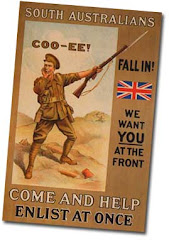Just finished doing the basic research on the six Broadbent boys from Cherry Gardens. They appear to have all been brothers or cousins:
Private Albert George Broadbent, 5th Pioneer Battalion: killed in action at Bullecourt, France 10 May 1917. Brother of Marshall Broadbent below.
Private Ralph Leslie Broadbent, 43rd Battalion, killed in action near Messines, Belgium 31 July 1917
Sapper Marshall Broadbent, 3rd Tunnelling Company, survived the war but died in an explosives accident at the Golden Horseshoe mine near Kalgoorlie, WA in 1940. Brother of Albert George Broadbent above.
Private Leland Keith Broadbent, 48th Battalion, survived the war and died aged 82 in 1980. Brother of Lindsay (Reg) Broadbent and Rowland Broadbent below.
Private Lindsay Reginald Broadbent, 32nd Battalion, wounded twice, lost one or both legs as a result, survived the war, died aged 85 in 1975. Brother of Leland Keith Broadbent above, and Rowland Broadbent below.
Corporal Rowland Broadbent, 11th Field Ambulance, gassed, survived war, Methodist clergyman, died in 1947 aged approximately 66. Brother of Leland Keith and Lindsay Reginald Broadbent above.
There is also Sapper Harry Franklin Broadbent, MM of the 2nd Divisional Signals Company who survived the war but apparently took his own life a few years later. Harry was a brother of Marshall and Albert George Broadbent above, but I can't find a link with Cherry Gardens for him.
I will be writing to the 'Cherry Chatter' team at Cherry Gardens to see if there is any more they can add.
The Oarsmen: The Remarkable Story of the Men Who Rowed from the Great War
to Peace
-
*Available from libraries and bookstores.*
At the end of the Great War the Department of Defence was faced with the
problem of repatriating tens of thousa...
1 day ago









